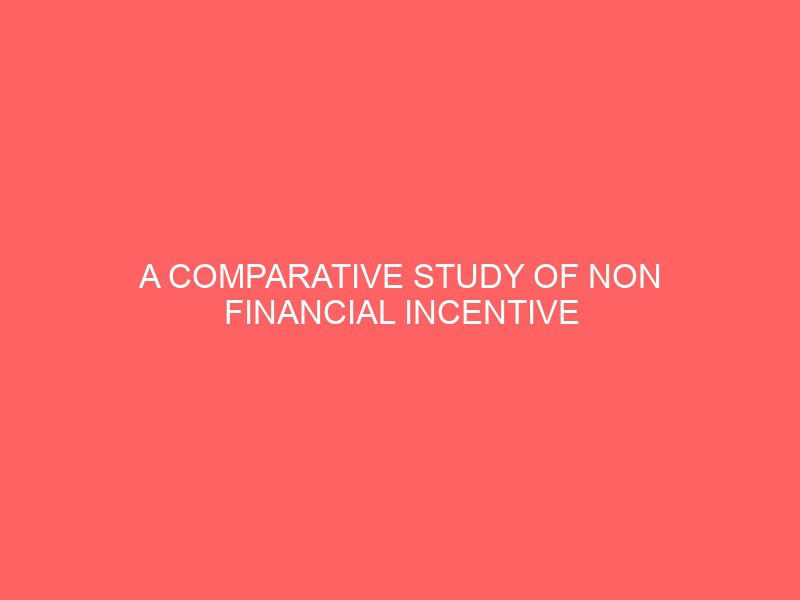Description
CHAPTER ONE
INTRODUCTION
1.1 BACKGROUND
Adequate worker remuneration has been found over the years to be one of the ways by which an organization can increase employee job satisfaction and invariably increase the organization’s productivity (Muogbo, 2013). Over the years especially with the present global economic trend, most employers of labour have realized that for their organizations to compete favourably, employee job satisfaction goes a long way in determining the success of the organization. Motivation of employees in any organization is vital, not only for the growth of the organization, but also for the growth of individual employees (Meyer and Peng, 2006).
The role of human efforts in achieving organizational goals cannot be overemphasized. The overall performance of an organization is directly dependent on the amount of efforts positively or negatively applied by workers individually or collectively towards attaining the desired goals (Agu, 2003). Optimal employee job satisafaction depends among other things on what kind of incentives put in place to motivate the workforce. Workplace incentives act as a link between desired employee attitude and outcomes that make an employee feel appreciated (Whetten and Cameron, 2007).
Incentives are important factors that determine the level of employee’s contribution to an organization. Incentives include economic benefits provided by the management of an organization such as pay, promotion, verbal recognition and rewards both financial and non financial which seek to attract employees to join an organization and keep them motivated within the organization for better employee job satisfaction. Employees’ motivation plays a vital role in employee work satisfaction, hence effective incentive systems in an organization may influence employees’ attitude in the workplace and bring about an overall turnaround with resultant positive organizational performance. After all, it is only the satisfied workers that will put in their best. Furthermore, with the appropriate incentives employees will develop positive attitudes towards their job, feel committed to the organization and become actively involved in the developmental processes of the organization. Satisfied employees are less likely to quit their jobs.
Incentives are categorized into two broad groups; financial and non financial incentives. Financial incentives, also called extrinsic rewards include pay, bonuses, allowances, insurance, promotions and job security while non financial incentives referred to as intrinsic rewards include recognition and appreciation of workers, meeting new challenges through provision of enabling environment, caring attitude from employers, mentor and mentee relationships and motivating the employee.
Non-financial incentives are a part of the various cost effective ways that organizations all over the world adopt in compensating employees, in order to attract, motivate and retain them in the workplace and they remain part of the factors that contribute to organizational overall success in achieving set goals and objectives. A non-financial incentive is crucial to an employee’s perception of the reward systems in the workplace environment (Khan, Shahid, Nawab, &Wali, 2013). The use of non-financial incentives in organizations serves to motivate employees towards workers job satisfaction. Organizations can only function with a motivated workforce who ensures efficiency, high organizational output and prosperity of the organization. De-motivated employees will most likely put in little or no effort in their assigned tasks, with low quality work output and may even leave the organization at the slightest better opportunity elsewhere. However, employees who are well motivated with incentives are most likely to be determined, creative and loyal to their organizations. Well motivated employees are dedicated and contribute positively to high organizational turn over, and this often results in optimum level of employee job satisfaction, retention, loyalty and overall organizational performance.
Previous studies (Orvill et al, 2000; Sonawane, 2008; Lotta, 2012; Saira et al, 2014) have shown that non-financial incentives are rated as powerful employee motivators for better employee job satisfaction than financial incentives. These non-financial incentives include top three non-financial strategies such as praise and commendation from immediate superior, attention from leaders, and opportunities to lead projects or task forces. Non-financial incentives may include workplace recognition of employee, rewards, opportunities, and flexibility. To put in their best, employees must feel welcomed, valued, and appreciated from time to time in an organization. Effective workplace non-financial incentives may be instrumental to making an employee feel appreciated and valued, thereby deriving some level of satisfaction from the job and the duties involved.
1.2 STATEMENT OF THE PROBLEM
Employers of labour both in the public and private sector of the Nigerian economy are becoming increasingly aware that employee motivation increases workplace productivity and employee job satisfaction. However, not many organizations realize that non-financial incentives go a long way in boosting the employee’s morale and instill a sense of responsibility in them to put in their best to move the organization forwards. This is because many organizations today both in the Nigerian Public and private sectors focus only on financial incentives as a means of motivating employees towards job satisfaction. Oftentimes, workers feel overworked and unappreciated by the companies for which they toil day in day out. Layoffs, stressful work conditions, ever-increasing demands, unappreciative bosses, and unsupportive workplace environment contribute to employee dissatisfaction and apathy.
Furthermore, it is worthy of note that money and other material things cannot always satisfy human beings. Aside from bonuses and other materialistic prizes, employees often have high expectations on receiving non-financial incentives such as recognitions, awards and praise from superior officers and management of the organizations that they work for. Hardworking employees are sometimes dissatisfied with the mere thought that someone somewhere in the organization recognizes their efforts no matter how little but refuses to praise or recognize them for it.
Every organization, whether public or private need motivated workers that are effective and efficient in carrying out their duties as this does not only increases organizational performance, it also gives the organization an edge over competitors. Employees who are motivated to work energetically and creatively towards accomplishment of organizational goals are one of the most important inputs to organizational success and performance. Hence, the challenge for organizations is how to ensure that their workers are highly motivated and the form of rewards or incentive systems to adopt for overall organizational performance (Orvill, 2000).
Studies have proven that rewarding employees is one of the ways to keep organizational workforce motivated with a significant relationship between reward and job satisfaction of employees and the overall performance of an organization. Motivation, therefore exerts a driving force on employee attitudes to work and invariably job satisfaction. However, few research studies have investigated the relationship between non-financial incentives and employee job satisfaction in Nigeria. Therefore, it becomes imperative to adopt an effective and reliable method of motivating employees for job satisfaction. In line with this purpose, this study focuses on the comparative study of non-financial incentives and employee job satisfaction in an organization.
1.3 AIM AND OBJECTIVES OF THE STUDY
The aim of this study is to make a comparative analysis of non-financial incentives and employee job satisfaction in organizations. Specifically, the objectives of the study are to:
To determine the impact of non-financial incentive on employee job satisfaction in an organization.
To investigate if there is any relationship between non financial incentive and employee job satisfaction in the organization.
To find out if recognition and praise has a positive impact on employees of the organization.
1.4 RESEARCH QUESTIONS
This research study will attempt to answer the following research questions;
Do non-financial incentives have any impact on employee job satisfaction in an organization?
Is there any relationship between non-financial incentives and employee job satisfaction in the organization?
Does recognition and praise have a positive impact on employees of the organization?
The following hypotheses are formulated to address the research question;
Ho1: Non-financial incentives do not have any impact on employee job satisfaction in an organization
Ho2: There is no relationship between non-financial incentives and employee job satisfaction in an organization.
Ho3: Recognition and praise has a positive impact on the employees of the organization
1.6 SIGNIFICANCE OF THE STUDY
This comparative study on non-financial incentives and employee job satisfaction has the following significance:
This study will be a useful guide to policy makers and management of companies in the implementation of policies on non-financial incentive packages for the employee.
This study will help the society at large as more organizations are increasingly becoming aware of non financial rewards which bothers on the basic needs of the employee.
Findings from this study will also add to the existing body of literature on the subject area, the comparative study of non-financial incentives and employee job satisfaction.
1.7 SCOPE OF THE STUDY
The scope of this study is limited to Seven Up Bottling Company. During this study, questionnaires shall be distributed to various categories of workers in all the selected staffs in various departments of the organization. Issues to be dealt with in this study include the impact of non financial incentives on workers’ attitude, workers’ satisfaction with the non-financial incentive system used by the organization; challenges and factors influencing adoption of the non-financial incentives.
1.8 OPERATIONAL DEFINITION OF TERMS
Employee: one employed by another or a company usually for wages and salary and in a position below the executive level
Incentives: encourages a person to do something or to work harder
Motivation: the act or process of giving someone a reason for doing something. The condition of being motivated or being eager to act or work.
Non financial incentives: some form of material reward especially which is different from money.
Satisfaction: fulfillment of one’s wishes, expectations, or needs, or the pleasure derived from this.
Organization: an administrative or functional structure such as a business or company formed for a particular purpose.
Organizational Performance: the actual output or results of an organization as measured against its intended outputs or goals and objectives.







